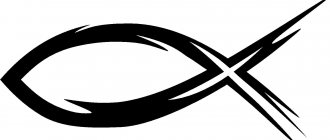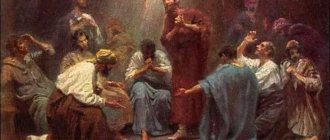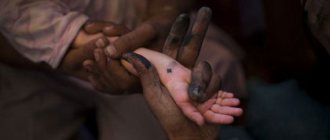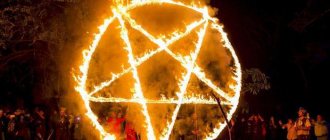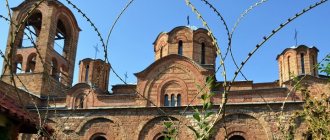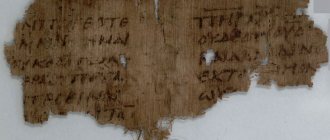Signs and symbols have existed on earth for a long time. They depict an attitude towards a certain culture, religion, country, clan or thing. The symbols of Christian Orthodox culture emphasize belonging to God, Jesus, the Holy Spirit, through faith in the Holy Trinity.
Orthodox Christians express their faith with Christian signs, but few, even those who are baptized, know their meaning.
Christian symbols in Orthodoxy
History of symbols
After the crucifixion and resurrection of the Savior, persecution began against Christians who believed in the coming of the Messiah. In order to communicate with each other, believers began to create secret codes and signs to help avoid danger.
Cryptogram or secret writing originated in the catacombs where early Christians had to hide. Sometimes they used long-known signs from Jewish culture, giving them new meaning.
The symbolism of the early Church is based on man's vision of the Divine world through the hidden depths of the invisible. The meaning of the emergence of Christian signs is to prepare early Christians to accept the Incarnation of Jesus, who lived according to earthly laws.
Secret writing at that time was more intelligible and acceptable among Christians than sermons or reading books.
Important! The basis of all signs and codes is the Savior, His Death and Ascension, the Eucharist - the Sacrament left by the Mission before His crucifixion. (Mark 14:22)
Cross
The cross symbolizes the crucifixion of Christ; its image can be seen on the domes of churches, in the form of crosses, in Christian books and many other things. In Orthodoxy there are several types of crosses, but the main one is the eight-pointed one, on which the Savior was crucified.
Cross: the main symbol of Christianity
A small horizontal crossbar served for the inscription “Jesus of Nazareth, King of the Jews.” The hands of Christ are nailed to the large crossbar, and His feet to the lower one. The top of the cross is directed to heaven, and the Eternal Kingdom, and under the feet of the Savior is hell.
About the cross in Orthodoxy:
Crescent on Orthodox crossesWhere to put the pectoral cross of a deceased personWhat is the difference between an Orthodox cross and a Catholic one
Fish - ichthys
Jesus called fishermen as his disciples, whom he later made fishers of men for the Kingdom of Heaven.
One of the first signs of the early Church was a fish; later the words “Jesus Christ the Son of God the Savior” were written into it.
Fish is a Christian symbol
Bread and vine
Belonging to the Eucharist or the Sacrament of Communion is expressed through drawings of bread and grapes, and sometimes wine or grape barrels. These signs were applied to sacred vessels and were understandable to everyone who accepted faith in Christ.
Important! The vine is a type of Jesus. All Christians are its branches, and the juice is a prototype of the Blood that cleanses us during the reception of the Eucharist.
In the Old Testament, the vine is a sign of the promised land; the New Testament presents the vine as a symbol of paradise.
The vine as a symbol of heaven in the New Testament
A bird sitting on a grape vine symbolizes rebirth to new life. Bread is often drawn in the form of ears of corn, which is also a sign of the unity of the Apostles.
Fish and bread
The loaves depicted on the fish refer to one of the first miracles performed by Jesus on earth, when He fed more than five thousand people who came from afar to listen to the preaching of the Mission with five loaves and two fish (Luke 9:13-14).
Why fish is a symbol of Christianity
ICHTIS (fish) is an abbreviation that appeared when translating the expression “Jesus Christ the Son of God the Savior” from Greek by adding the first letters.
Next to Jesus there were many apostles - fishermen. He called them “fishers of men,” and associated himself with Alpha and Omega (the beginning and end of all life). By depicting fish, Christians preached their faith and recognized fellow believers.
According to some sources, the fish became a symbol due to its ease of availability.
Symbolism common in Orthodox iconography and architecture
In Orthodox culture, over two millennia, various religious signs have been used to denote deep meaning. They are depicted in icons, temple paintings, architecture and church vestments.
A complete description of the symbolism of Orthodox iconography has an impressive volume. The article presents its main known elements.
A halo is considered a sign of holiness on icons
A halo, as a symbol of holiness, is depicted around the head.
Examples of a halo in the temple painting of the Bistritsa monastery, Moldova and mosaics from the Assist workshop, Vinnitsa
The ship is a symbol of the church
On ancient paintings, the church is depicted in the form of a ship, as a refuge for people escaping in the raging sea of worldly temptations.
Image of the Holy Orthodox Church. On the ship the helmsman is Christ, the Holy Apostles, Saints and the Virgin Mary are steering
Arrows or swords piercing the Mother of God
This symbol appeared as a result of the prophecy of Simeon the God-Receiver, who said, addressing the Mother of God:
(Luke: 2.35)
“And a weapon will pierce your own soul, so that the thoughts of many hearts may be revealed.”
Icon of the Mother of God “Softening Evil Hearts”, or “Seven Arrows”. Seven arrows piercing the heart signify the fullness of grief experienced by the Virgin Mary
Star of Bethlehem
This is a symbol of the star that led the Magi to the cave in which the Savior was born. It is usually depicted with 8 rays.
The icon of the Nativity of Christ depicts the Magi and the star that led them
According to tradition, Christmas carols are accompanied by the image of the Star of Bethlehem.
Orthodox children sing Christmas cants
Temple symbolism
Each fragment of the temple has a specific meaning.
Temple shape:
- cross - salvation from the devil, entrance to heaven;
- circle - the inviolability of the Church;
- The eight-pointed star is the salvation of the human soul.
Dome shape:
- helmet-shaped - the Church’s fight against evil;
- in the form of an onion - a candle flame.
Dome Color:
- gold - dedicated to Christ;
- blue with stars - to the Blessed Virgin Mary;
- green - Trinity.
An Orthodox church is a collection of many sacraments, the meaning of which can only be understood by a true believer.
Cross "Grapevine"
This is an eight-pointed cross with the image of thin branches of grapes. Sometimes the Savior may be depicted in the center.
Grapes are the personification of wisdom and immortality. The ministers of the church are the branches, and the grapes are the sign of Communion. Leaves and berries symbolize Christ's sacrifice of himself for the sake of people. Such a cross will always remind of God’s love for everyone who believes in him.
Image of Christ the Savior
Orthodox symbols and signs, and their meaning, originate from the catacombs of Italy, where the disciples of Christ performed divine services in conditions of severe persecution by the authorities. Early Christianity did not know icon painting, and expressed on the walls not Christ himself, but his essence. You can see the Lamb, grape vines, bread, the Good Shepherd.
Early symbolism can be considered the “Adoration of the Volkhs.” Researchers discovered 12 frescoes with a date from the 2nd century, after the events described in the Gospel. This is evidence of the prediction of the resurrection and a symbol of the connection between the Old and New Testaments. At the same time, writing in Greek hieroglyphs appeared, which in Russian sounds like “Ichthys,” which means fish. The Good Shepherd and “Ichthys” are the first images of Christ from the period of early Christianity. The symbolism of “Ichthys” was used by sailors to depict a god close to them.
Chrisma is the monogram of the name of Christ, consists of the letters X and P, with hieroglyphs on the sides. It is often found in the design of temples, like other signs.
Dear brothers and sisters! We invite you to visit the unique resource https://www.slovo-pomoshi.ru/. With its help, you can convey your aspirations to St. Petersburg churches, chapels, monasteries, and also contact the righteous at the place of their burial. We will write a note ourselves, take it to the temple and send you a photo report by email. Turning to God with the help of prayers has helped many people overcome grief, regain health and the joy of worldly life.
Useful articles:
“Parental curses are very powerful.” Know that the curse, even (simple) parental indignation, is very powerful. And even if the parents did not curse their children, but simply became indignant because of them, then the children do not have a single bright day in their lives: their whole life is one continuous torment. Then such de... Read more
Parable. When the Lord commands... A poor woman from a small family was very religious. And one day, when there was not enough money even to feed the children, she called the radio station and left there an appeal to God for help. While the radio employees treated the believing woman with understanding... Read more
FOR ALL MEN READ: A letter from a man who has been married for 30 years. The sailboat freezes helplessly without wind in its sails. The car stalls without gasoline. And even strong women run out of strength. Peace in the family is incomparably better than stupid male justice. Having lived a married life for almost 30 years, I began to realize that women are a friend... Read more
About the prayer of the last Optina elders Archpriest Andrei Tkachev about prayer for those who do not have time to pray. A believer must pray, nothing new here. He must want to pray, which is more difficult, because not everyone wants to. You need to force yourself to pray. But the rule is long, time is short, and we get tired, and we suffer, and... Read more
The cross is a sign of the Christian faith, and the anchor is a latent image of the cross. There are several types of crosses. This is a Latin, Greek, inverted cross, the cross of Golgotha. It is surprising, but the first Orthodox did not worship in front of the cross. Over time, it became the main attribute of churches and people.
The earliest images of Christ's crucifixion included clothing and a crown, later a crown of thorns, nails and blood. The crown of thorns symbolizes the suffering of Christ.
The Lamb symbolizes Christ's sacrifice for the salvation of sinful people. During the birth of Christianity, the sign was convenient; it depicted a harmless lamb. This symbol could be worn openly and not hidden. But in 680 it was abolished in Constantinople. From this time begins the era of icon painting of Christ.
Must read: What does canon mean and how does it differ from akathist
When the Archangel Gabriel came to the Virgin Mary with the news of her destiny, her hands held a white lily. Lily is a sign of the chastity of the Holy Virgin. This became the basis for depicting saints with a lily in their hands on icons.
SIGNS OF THE MONTH HOLIDAYS
Starting from the first printed Moscow Typikon of 1610, used in Russian. Z. p.m. traditions include the sign of the great holidays, the signs of the middle holidays and, the signs of the minor holidays and and “without a sign” (services with “Alleluia”, which also do not have a sign, do not belong to the minor holidays). In this form, the Z. p.m. system is focused primarily on the liturgical features of each type of holiday, and not on the regulations on bowing and fasting.
The great holidays with the sign include the fixed twelfth holidays, the holidays of the Intercession of the Most Holy. Theotokos (Oct. 1), Nativity (June 24) and the Beheading of St. John the Baptist (August 29), in memory of the apostles Peter and Paul (June 29), St. Basil the Great and the Feast of the Circumcision of the Lord (Jan. 1). The main feature of the service on these days is the all-night vigil, during which the entire hymnography is dedicated to the holiday. Within the framework of this order, the Lord's holidays are united, which have liturgical features and, when coinciding with Sunday, displace the Sunday observance of the Octoechos; Theotokos feasts, when coinciding with Sunday, connect their sequences with the Sunday service of Octoechos; holidays in the name of saints. Within each group, differences between holidays can also be noted.
On the days of the middle holidays with the sign, the Crimea refers primarily to the days of memory of the most revered saints - St. John the Evangelist, St. Nicholas of Myra and others - an all-night vigil is also celebrated. The service is similar to the service on the days of remembrance of saints, marked with the sign, but at Matins the canon to the saint is preceded by a special or general canon of the Most Holy. Mother of God. The troparia in the canon of Matins are sung at 14 (6 troparia (counting the irmos) to the Most Holy Theotokos and 8 to the saint), the stichera at Vespers on “Lord, I cried” - at 8. The ordinary (but not Sunday) service of the Octoechos is omitted.
Middle holidays with the sign, which include celebrations in honor of revered icons of the Mother of God and the memory of revered saints, do not have an all-night vigil - Vespers and Matins are performed at their own time (in practice they can be combined, but not in the same way as during a vigil), at In this case, both Vespers and Matins are served according to the festive rite (i.e. Vespers is great and includes the entrance and paremias, Matins has a polyeleos, reading of the Gospel and a festive ending with the singing of a great doxology). Since vigils are not celebrated on such holidays, Compline and the Midnight Office are not canceled on these days. In the Typikon one finds the designation of such holidays with the phrase “holy have polyeleos”; in everyday life they are often called “polyeleos”. At Vespers for “Lord, I have cried,” the stichera are usually sung at 8, sometimes at 6 (at 6, stichera on the Polyelean holidays were usually assigned in the older editions of the Jerusalem Typicons, which remained in the modern edition on certain days - September 28 ., January 11, February 24, May 25); canon at Matins - as at the sign. Sometimes the Typikon prescribes a litia with stichera for the saint on holidays with the sign, although it is not obligatory for this type of holiday (in modern Russian practice it is omitted in most cases). The ordinary (but not Sunday) service of Octoechos (except for the canon at Compline) is omitted.
Among the small holidays marked with the sign, or doxological, at least 2 types of services can be distinguished. The main feature of all remembrances with this sign is the festive ending of Matins (with the singing of a great doxology; Matins with such an ending have other small differences from the daily one); Vespers can be both great (during doxological services in the evening on the days of the Nativity of Christ and the Baptism of the Lord, on the 13th of September, etc., i.e., during the Lord's services with doxology), and daily (during doxological services in honor of the saints). The chants of Octoechos in the service can either be preserved (for example, September 23, December 9) or canceled (for example, July 2, August 31). The verses on “Lord, I cried” are sung at 6; the number of troparions of the canon also includes 6 troparions for the holiday. Among the doxological services in Russian. Typicon - many memories of Russians. saints canonized in the 16th-17th centuries. This is due to the fact that Russian Church authorities of that time wanted to highlight the Russian. saints, but at the same time they could not assign polyeleos services to all of them; Russian services Saints canonized after the 17th century, as a rule, immediately received the polyeleos sign.
In contrast to services on holidays marked with the sign, services on minor holidays with a sign (which differs from the previous one only in color) can rightfully be called daily, and not holiday (see Art. Everyday services). None of the 24-hour services these days have any service. festive features (not counting the singing of “God is the Lord” at Matins). Saints whose memorial days have this sign are usually called “sung on 6” or “six-fold”, since their stichera on “Lord, I cried” are sung on 6 (the stichera of Octoechos on “Lord, I cried” are canceled), and among the troparions of the canon there are also 6 troparions to the saint - this is the main feature of holidays with the sign. The features of the six-member service also include the presence of a number of hymns - praises on “Lord, I cried” and on the verse, kontakion with ikos, luminary; the minimum hymnographic set does not have these chants.
In pre-Nikon editions of the Typikon, the sign may mark the days of the forefeast (September 7, February 1, March 24, August 5 and 14), although the service to the saints of these days does not always correspond to such a sign (the troparion may be missing - August 5 and 14, stichera on “Glory” - September 7; on March 24, only the sequence of the forefeast is sung, and there is no celebration of the saint at all). Thus, in these cases the sign referred specifically to the service of the pre-festival. In modern publications do not have the forefeast sign.
The service of small holidays “without a sign” differs from the sixfold one only in the smaller volume of the hymns of the Menaion in relation to the hymns of the Octoechos: on “Lord, I cried” 3 stichera of the Octoechos and 3 saints are sung, the canon at Matins consists of 10 troparions of the Octoechos (including the Irmos) and only 4 troparions to the saint (for this reason, a number of charterers designate the service of the small holiday “without a sign” as quaternary; in pre-Nikon practice there was also the term “osmerik” - for the memory of saints with signs and). Additional hymns of the Menaion, always present in sixfold memories, may or may not be present in memories “without a sign”. At the same time, the service “without a sign” with “God is the Lord” is contrasted with the fast service with “Alleluia” (in the old editions of the Jerusalem Rule, on the contrary, one can see that the absence of a holiday sign usually implies the absence of a troparion to the saint and, consequently, a service with “Alleluia” at morning). The service in honor of the two minor saints can be designated both as a sixfold service and as a service “without a sign.”
Jesus Christ - in symbols and codes
The Savior acts as the Good Shepherd for his sheep, Christians. At the same time, He is the Lamb slain for our sins, He is the saving cross and anchor.
The Ecumenical Council of 692 banned all symbols relating to Jesus Christ in order to shift the emphasis not on the image, but on the Living Savior, however, they still exist today.
Lamb
A small lamb, obedient, defenseless, is a prototype of the sacrifice of Christ, who became the final sacrifice, for God became displeased with the sacrifices made by the Jews in the form of slaughtering birds and animals. The Most High Creator wants Him to be worshiped with pure hearts through faith in His Son, the Savior of mankind (John 3:16).
Symbol of Lamb with Banner
Only faith in the saving sacrifice of Jesus, who is the way, the truth and the life, opens the way to eternal life.
In the Old Testament, the lamb is a type of the blood of Abel and the sacrifice of Abraham, to whom God sent a lamb to sacrifice instead of his son Isaac.
The Revelation of John the Theologian (14:1) speaks of a lamb standing on a mountain. The mountain is the universal Church, the four streams - the Gospels of Matthew, Mark, Luke and John, which nourish the Christian faith.
Early Christians in secret writing depicted Jesus as the Good Shepherd with a lamb on his shoulders. Nowadays priests are called shepherds, Christians are called sheep or flock.
Monograms of the name of Christ
Translated from Greek, the monogram “crisma” means anointing and is translated as a seal.
By the blood of Jesus Christ we are sealed to His love and salvation. Hidden behind the letters XP is an image of the Crucifixion of Christ, God Incarnate.
The letters "alpha" and "omega" represent the beginning and the end, symbols of God.
Monograms of the name of Jesus Christ
Little-known encoded images
Ship and anchor
The image of Christ is often conveyed by signs in the form of a ship or an anchor. In Christianity, the ship symbolizes human life, the Church. Under the sign of the Savior, believers in a ship called the Church sail towards eternal life, having an anchor - a symbol of hope.
Pigeon
The Holy Spirit is often depicted as a dove. A dove landed on Jesus' shoulder at His baptism (Luke 3:22). It was the dove that brought the green leaf to Noah during the flood. The Holy Spirit is One of the Trinity, Who was from the beginning of the world. The dove is the bird of peace and purity. He flies only where there is peace and quiet.
The symbol of the Holy Spirit is a dove
Eye and triangle
The eye inscribed in the triangle means the all-seeing eye of the Most High God in the unity of the Holy Trinity. The triangle emphasizes that God the Father, God the Son and God the Holy Spirit are equal in Their purpose and are one. It is almost impossible for a simple Christian to understand this. This fact must be accepted by faith.
Mother of God star
At the birth of Jesus, the Star of Bethlehem, which in Christianity is depicted as eight-pointed, lit up in the sky. In the center of the star is the bright face of the Mother of God with the Child, which is why the name Mother of God appeared next to Bethlehem.
In its four corners are visible images in the form of a man, an eagle, a lion and a calf, under which the four Gospels are encoded.
About the stars:
- What does a six-pointed star mean in Orthodoxy?
- About the five-pointed star in Orthodoxy
- Eight pointed star
Theotokos eight-pointed star
The Evangelist Mark is represented by a lion, praising the power and royal dignity of Jesus. The calf symbolizes the Evangelist Luke, who in his message emphasized the sacrifice of Christ, after which the calf became a prototype of the martyrs.
Jesus in human form is described by the Evangelist Matthew, he is the angel or man depicted in the upper left corner.
John the Evangelist is symbolized by the eagle, which represents the Holy Spirit and the Resurrection of Jesus Christ.
Little-known Christian symbols
| Image | Symbol | Meaning |
| Anchor | Symbol of hope for the future Resurrection | |
| Phoenix | Symbol of Resurrection and new life. | |
| Rooster | Symbol of the Resurrection | |
| Eagle | Symbol of ascension. Sign of John the Evangelist. | |
| a lion | Symbol of Resurrection and vigilance. Sign of the Evangelist Mark. | |
| Taurus | Symbol of martyrs. Sign of the Evangelist Luke. | |
| Peacock | Symbol of Paradise and immortality. | |
| Lily | Symbol of purity | |
| Pelican | Symbol of Christ's self-sacrifice | |
| Scull | Symbolizes victory over death. Adam's sign. | |
| crown of thorns | Symbol of Christ's suffering. |
By leaving a comment, you accept the user agreement
Login using:
Your email address will not be published. Fill in the fields marked *
